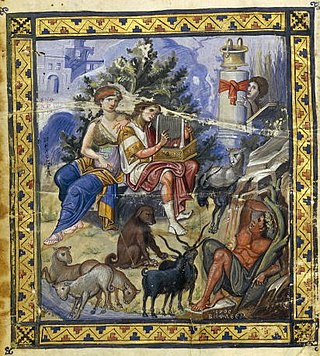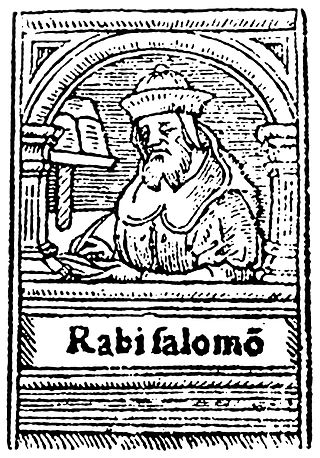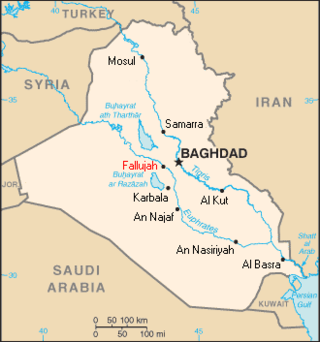
The Book of Psalms, also known as the Psalms, or the Psalter, is the first book of the third section of the Hebrew Bible called Ketuvim ("Writings"), and a book of the Old Testament.

Shlomo Yitzchaki, generally known by the acronym Rashi, was a medieval French rabbi, the author of comprehensive commentaries on the Talmud and Hebrew Bible.

Saʿadia ben Yosef Gaon was a prominent rabbi, gaon, Jewish philosopher, and exegete who was active in the Abbasid Caliphate.
Sefer Yetzirah is the title of a book on Jewish mysticism, although some early commentators, such as the Kuzari, treated it as a treatise on mathematical and linguistic theory as opposed to Kabbalah. The word Yetzirah is more literally translated as "Formation"; the word Briah is used for "Creation". The book is traditionally ascribed to the patriarch Abraham, although others attribute its writing to Rabbi Akiva. Modern scholars have not reached consensus on the question of its origins. According to Rabbi Saadia Gaon, the objective of the book's author was to convey in writing how the things of our universe came into existence. Conversely, Judah Halevi asserts that the main objective of the book, with its various examples, is to give to man the means by which he is able to understand the unity and omnipotence of God, which appear multiform on one side and, yet, are uniform.

Hai ben Sherira better known as Hai Gaon, was a medieval Jewish theologian, rabbi and scholar who served as Gaon of the Talmudic academy of Pumbedita during the early 11th century. He was born in 939 and died on March 28, 1038. He received his Talmudic education from his father, Sherira ben Hanina, and in early life acted as his assistant in teaching. In his forty-fourth year he became associated with his father as "av bet din," and with him delivered many joint decisions. According to Sefer HaKabbalah of Rabbi Abraham ben David (Ravad), he was the last of the Geonim.
Yefet ben Ali was perhaps the foremost Karaite commentator on the Bible, during the "Golden Age of Karaism". He lived about 95 years, c. 914-1009. Born in Basra in the Abbasid Caliphate, he later moved to Jerusalem between 950 and 980, where he died. The Karaites distinguished him by the epithet maskil ha-Golah.
Yiram of Magdiel was a minor Italian Jewish commentator on the Bible, active in Rome. The term Magdiel, which appears in Genesis 36:43, was apparently interpreted as Rome, so that his name was really Yiram of Rome.
Peshat is one of the two classic methods of Jewish biblical exegesis, the other being Derash. While Peshat is commonly defined as referring to the surface or literal (direct) meaning of a text, or "the plain literal meaning of the verse, the meaning which its author intended to convey", numerous scholars and rabbis have debated this for centuries, giving Peshat many uses and definitions.

Wigand of Marburg was a German herald of the Teutonic Knights in Prussia and one of the notable chroniclers of the Middle Ages.
Shem Tov ben Abraham ibn Gaon was a Spanish Talmudist and kabbalist.
Samuel ben Hofni. He was the gaon of Sura Academy in Mesopotamia ("Babylonia") from 998 to 1012.

Abraham (Adolf) Berliner was a German theologian and historian, born in Obersitzko, in the Grand Duchy of Posen, Prussia. He was initially educated by his father, who was the teacher in Obersitzko. He continued his education under various rabbis, later studying at the University of Leipzig where he received the degree of doctor of philosophy.

David Kaufmann was a Jewish-Austrian scholar born at Kojetín, Moravia. From 1861 to 1867 he attended the gymnasium at Kroměříž, Moravia, where he studied the Bible and Talmud with Jacob Brüll, rabbi of Kojetín, and with the latter's son Nehemiah.

Wilhelm Bacher was a Jewish Hungarian scholar, rabbi, Orientalist and linguist, born in Liptó-Szent-Miklós, Hungary to the Hebrew writer Simon Bacher. Wilhelm was himself a prolific writer, authoring or co-authoring approximately 750 works. He was a contributor to many encyclopedias, and was a major contributor to the landmark Jewish Encyclopedia throughout all its 12 volumes. Although almost all of Bacher's works were written in German or Hungarian, at the urging of Hayyim Nahman Bialik many were subsequently translated into Hebrew by Alexander Siskind Rabinovitz.
According to the Hebrew Bible, the Asuppim was a location or set of locations in the Second Temple. The word appears to be a masculine plural noun formed of the root אספ gather, and is usually translated "storehouses". The word appears three times in the Hebrew Bible, once in Neh 12:25 and twice in 1 Chr 26. Levite guards were stationed at the Asuppim. In Nehemiah, the guards of the Asuppim are given as follows: Mattaniah, Bakbukiah, Obadiah, Meshullam, Talmon, and Akkub. In 1 Chronicles, the guarding of the Asuppim is given to "the sons of Obed-Edom" who guard it "two by two ". John Lightfoot argues the Asuppim was located along the western wall of the Temple, though David Qimḥi, pseudo-Abraham b. David, David Altschuler, and Alexander Bennett M'Grigor put it to the south.
Raphael Kirchheim was a German Jewish scholar.
Moshe ben Chasdai Taku was a 13th-century Tosafist from Tachov, Bohemia. Despite his own seemingly mystical orientation, Rabbi Taku is controversially known to have been an opponent of both the esoteric theology of the Chassidei Ashkenaz and the philosophical orientation of rabbinic rationalists such as Saadia Gaon, Maimonides, Abraham ibn Ezra et al. He believed that both trends were a deviant departure from traditional Judaism, which he understood to espouse a literal perspective of both the biblical narrative, and the Aggadata of the Sages. His opposition to all theological speculation earned him, in the opinion of Gershon Scholem, the title of one of the two truly reactionary Jewish writers of the Middle Ages.
Carl Franz van der Velde was a German author of historical novels.
Nahum Ma'arabi was a Moroccan Hebrew poet and translator of the thirteenth century.

Philipp Wasserburg was a German Roman Catholic writer, publicist and member of the parliament of Hesse. He wrote under the pseudonym Philipp Laicus.








